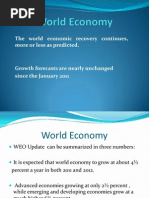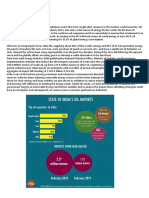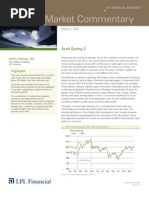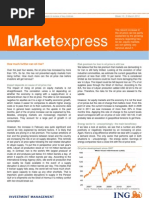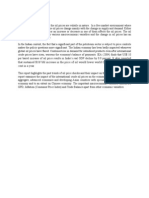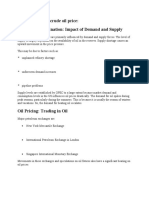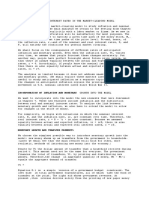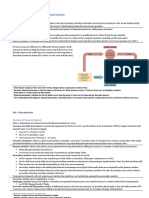Oil Scarcity
Oil Scarcity
Uploaded by
Angel ZainabCopyright:
Available Formats
Oil Scarcity
Oil Scarcity
Uploaded by
Angel ZainabOriginal Description:
Original Title
Copyright
Available Formats
Share this document
Did you find this document useful?
Is this content inappropriate?
Copyright:
Available Formats
Oil Scarcity
Oil Scarcity
Uploaded by
Angel ZainabCopyright:
Available Formats
* Column title, "Equilibrium" * Suggested story title: Oil Scarcity * Author: Dennis Botman, IMF Resident Representative to the
Philippines
Oil Scarcity Commodity prices have quickly returned to high levels, owing to structural as well as cyclical and special factors, and market pressures remain elevated. Among commodity prices, oil plays a particularly central role for the global economic outlook. The latest World Economic Outlook (WEO) discusses in detail the tension between the rapid growth in oil demand and the downshift in oil supply trends and its implications for global growth and imbalances (available at: http://www.imf.org/external/pubs/ft/weo/2011/01/index.htm). Oil is a key factor of production, including in the production of other commodities and in transportation, and is also a widely used consumption good. Oil is the most traded commodity, with world exports averaging US$1.8 trillion annually during 200709, which amounted to about 10 percent of total world exports in that period. This means that changes in oil market conditions have direct and indirect effects on the global economy, including on growth, inflation, external balances, and poverty. Since the late 1990s, oil prices have generally risennotwithstanding cyclical fluctuationsand supply constraints are widely perceived to have contributed to this trend. This has raised concerns that the oil market is entering a period of increased scarcity. In the short term, the outlook for oil markets remains quite uncertain, as perceptions of geopolitical supply risks can be volatile. Cyclical and special factors seem to explain much of the recent commodity price behavior. In fact, the magnitude of the actual oil supply shock has, in historical comparison, been moderate to date. Indeed, current OPEC spare capacity levels, estimated at about 4 percent of global demand, are sufficient to make up for losses of supply from Libya and to meet the expected increase in demand. However, Middle-East and North Africa (MENA) oil supply risks will probably only gradually unwind through 2011. Hence, in the WEO baseline, oil prices are projected to average about $107 per barrel in 2011 and 2012 from $79 in 2010. In the near term, the oil supply risks and continued robust global activitynotwithstanding some slowingmeans that upside risks to oil prices will remain high. Oil derivative markets have indeed started to price in higher risks of price spikes over the next few years. Against this backdrop, oil market risks have become an important concern for global economic stability and further surprises because of supply disruptions is the key downside risk for global growth. Turning to the medium term, even assuming that supply disruptions in the MENA region are short-lived, oil prices are expected to remain high, reflecting the tension between continued robust oil demand growth and the downward shift in the trend growth rate of global oil production. Indeed, persistent commodity price increases in recent years point to a break with
-2-
the experience of the 1980s and 1990s as well as with the experience of earlier commodity price booms. Concern about resource scarcity is more widespread now than a decade or two ago. The analysis of demand and supply prospects for crude oil suggests that the increased scarcity arises from continued tension between rapid growth in oil demand in emerging market economies (primarily China, which is now the largest energy consumer in the world) and the downshift in oil supply trend growth (due to oil fields reaching maturity and long lags between investment planning and delivery limiting capacity expansion). If the tension intensifies, whether from stronger demand, traditional supply disruptions, or setbacks to capacity growth, market clearing could force price spikes, as in 200708. As for the effects on the global economy, the simulation analysis in the WEO suggests that the impact of increased oil scarcity on global growth could be relatively minor if it involves primarily a gradual downshift in oil supply growth rather than an absolute decline. In particular, a sizable downshift in oil supply trend growth of 1 percentage point appears to slow annual global growth by less than percent in the medium and longer term. On the other hand, a persistent decline in oil supply levels could have sizable negative effects on output even if there is greater substitutability between oil and other primary energy sources. The oil-induced wealth transfer from oil importers to exporters can increase capital flows, reduce the real interest rate, and widen current account imbalances. GDP of oil importers declines, but they initially experience two countervailing effects that support output. The first, and more important, is a surge in goods exports to oil exporters to satisfy their increasing domestic demand. The second is a surge in investment demand in response to lower world real interest rates. This occurs because the oil exporters additional oil revenue, which accrues primarily to governments, leads to higher saving, which reduces world real interest rates by almost 100 basis points over 20 years. This effect is reminiscent of the international lending boom in the 1970s and early 1980s following large oil price increases. Regional differences among oil importers in this phase of the adjustment stem mostly from differences in the strength of their export links with oil exporters, with GDP in emerging Asia and Japan benefiting the most from the consumption boom in that region. In addition, emerging Asia also benefits more from lower world real interest rates, in view of the regions higher propensity to invest. Global imbalances worsen in this scenario over the short to medium term. Macroeconomic and structural policies can help economies adjust to unexpected changes in oil scarcity. Removing real rigidities in product and labor markets may mitigate the initial shock by facilitating the smooth reallocation of resources. Rather than ad-hoc tax measures, which tend to be regressive and inefficient, such policies need to be complemented with efforts to strengthen targeted social safety nets, because higher oil prices could lead to shifts in income distribution and to increased poverty.
The Author is the IMF Resident Representative for the Philippines
You might also like
- BKM Solution Chapter 5Document6 pagesBKM Solution Chapter 5minibod100% (1)
- E&P-Industry Analysis PaperDocument9 pagesE&P-Industry Analysis Paper10manbearpig01No ratings yet
- He Impact of Oil Prices On The Economic Growth and Development in The Mena CountriesDocument25 pagesHe Impact of Oil Prices On The Economic Growth and Development in The Mena CountriesKamranNo ratings yet
- R.Lakshmi Anvitha (1226213102) : Green TechnologiesDocument8 pagesR.Lakshmi Anvitha (1226213102) : Green TechnologiesTejeesh Chandra PonnagantiNo ratings yet
- WOO Boxes World Economy Oil PricesDocument3 pagesWOO Boxes World Economy Oil PricesمسعودNo ratings yet
- Iv. Oil Price Developments: Drivers, Economic Consequences and Policy ResponsesDocument29 pagesIv. Oil Price Developments: Drivers, Economic Consequences and Policy Responsesdonghao66No ratings yet
- Ii. Economic: ReviewDocument12 pagesIi. Economic: ReviewPrateek SinghNo ratings yet
- Declining Oil Rev NigeriaDocument12 pagesDeclining Oil Rev NigeriaAltay KalpakNo ratings yet
- OPEC Oil Outlook 2030Document22 pagesOPEC Oil Outlook 2030Bruno Dias da CostaNo ratings yet
- Monetary Policy Module 5Document6 pagesMonetary Policy Module 5Idyelle Princess Salubo MalimbanNo ratings yet
- Understanding Shocks of Oil Prices: IJASCSE Vol 1 Issue 1 2012Document7 pagesUnderstanding Shocks of Oil Prices: IJASCSE Vol 1 Issue 1 2012IJASCSENo ratings yet
- Effects of Oil Prices ON Economy: Muhammad Junaid Mughal ASC 2625 CMS 281144 SEC C 91Document20 pagesEffects of Oil Prices ON Economy: Muhammad Junaid Mughal ASC 2625 CMS 281144 SEC C 91Junaid MughalNo ratings yet
- Oil Price Shocks and The Nigeria Economy: A Variance Autoregressive (VAR) ModelDocument11 pagesOil Price Shocks and The Nigeria Economy: A Variance Autoregressive (VAR) ModelDiamante GomezNo ratings yet
- Crude Oil Price, Monetary Policy and Output: Case of PakistanDocument15 pagesCrude Oil Price, Monetary Policy and Output: Case of PakistanƁiLдL дhmed RajpootNo ratings yet
- 6504 16164 1 PB PDFDocument6 pages6504 16164 1 PB PDFYew Wen KhangNo ratings yet
- Political FactorsDocument8 pagesPolitical Factorsgoldensparrow88No ratings yet
- The World Economic Recovery Continues, More or Less As PredictedDocument52 pagesThe World Economic Recovery Continues, More or Less As PredictedSaloni PuriNo ratings yet
- Sprott On OilDocument10 pagesSprott On OilMariusz Skonieczny100% (1)
- Crude Oil Market & Factors Impacting PricesDocument7 pagesCrude Oil Market & Factors Impacting PricesrohitNo ratings yet
- Oil Price Paths in 2017 Is A Sustained Recovery of The Oil Price Looming OIES Energy InsightDocument15 pagesOil Price Paths in 2017 Is A Sustained Recovery of The Oil Price Looming OIES Energy InsightKalpesh BhagneNo ratings yet
- Eco-Before The ModelDocument15 pagesEco-Before The ModelPramesh ChandNo ratings yet
- Critique PaperDocument4 pagesCritique PaperKaye Annzelle SALAMATNo ratings yet
- Aaaaaaaaaaaaaaaa A Aaa A Aaaaaaaaaaaa Aa A Aa A Aa Aaa A A A ADocument3 pagesAaaaaaaaaaaaaaaa A Aaa A Aaaaaaaaaaaa Aa A Aa A Aa Aaa A A A AM Kashif RazaNo ratings yet
- Oil Prices tcm16-20271 PDFDocument26 pagesOil Prices tcm16-20271 PDFibidaboNo ratings yet
- Weekly Market Commentary 3-5-2012Document3 pagesWeekly Market Commentary 3-5-2012monarchadvisorygroupNo ratings yet
- The Future of Commodity Markets in IndiaDocument11 pagesThe Future of Commodity Markets in Indiakumar vivekNo ratings yet
- Marketexpress: How Much Further Can Oil Rise?Document2 pagesMarketexpress: How Much Further Can Oil Rise?fatima786No ratings yet
- ADL BaseOilDocument4 pagesADL BaseOilhazmijemiNo ratings yet
- Research ReportDocument13 pagesResearch ReportShahroz AslamNo ratings yet
- Effect of Crude Oil Prices On Indian Economy Economics EssayDocument33 pagesEffect of Crude Oil Prices On Indian Economy Economics EssayVijji ReddyNo ratings yet
- Written by Nwala Vincent Nkem 20141922873: A Term Paper OnDocument5 pagesWritten by Nwala Vincent Nkem 20141922873: A Term Paper OndanoskiNo ratings yet
- Study of The Impact of Crude Oil Prices On Economic Output and Inflation in Saudi ArabiaDocument12 pagesStudy of The Impact of Crude Oil Prices On Economic Output and Inflation in Saudi Arabiajasjass20914No ratings yet
- It Also Reported That Sustained $10/ BBL Increase in The Price of Oil Would Lower World GDP by at Least 0.5 Per Cent in A YearDocument18 pagesIt Also Reported That Sustained $10/ BBL Increase in The Price of Oil Would Lower World GDP by at Least 0.5 Per Cent in A YearAbhimanyu KumarNo ratings yet
- Adjustment in The Oil Market Structural Cyclical or BothDocument23 pagesAdjustment in The Oil Market Structural Cyclical or BothjaehyukNo ratings yet
- Oil Price Shocks and Nigeria S Macro EconomyDocument25 pagesOil Price Shocks and Nigeria S Macro EconomyMarc Roland LissangoNo ratings yet
- Executive Summary: Report Had Pointed at A Looming Surge in Implied OPEC Spare Capacity, An Expression of The SupplyDocument7 pagesExecutive Summary: Report Had Pointed at A Looming Surge in Implied OPEC Spare Capacity, An Expression of The SupplyCarlos SosaNo ratings yet
- Texas OilDocument4 pagesTexas OilAdminAliNo ratings yet
- Oil Price DissertationDocument7 pagesOil Price DissertationDoMyPaperForMeUK100% (1)
- Term Paper Pakistan EconomyDocument36 pagesTerm Paper Pakistan EconomyKhola ShahidNo ratings yet
- Implact of Oil Prices On GCCDocument8 pagesImplact of Oil Prices On GCCkissonlyshing2022No ratings yet
- Lecture Notes On Introduction To Oil and Gas Industry Jan2015Document10 pagesLecture Notes On Introduction To Oil and Gas Industry Jan2015Domo YhlNo ratings yet
- Research Paper - Oil Crisis in The 21ST CenturyDocument6 pagesResearch Paper - Oil Crisis in The 21ST CenturyAdil VasudevaNo ratings yet
- 1-s2.0-S026499932400021X-main 5Document2 pages1-s2.0-S026499932400021X-main 5afakih.lbNo ratings yet
- World Oil Demand and The Effect On Oil Prices 3Document16 pagesWorld Oil Demand and The Effect On Oil Prices 3Bhanu MehraNo ratings yet
- Essay: The Determinants of Oil PricesDocument2 pagesEssay: The Determinants of Oil PricesJennyNo ratings yet
- Price Dynamics of Crude OilDocument3 pagesPrice Dynamics of Crude OilnitroglyssNo ratings yet
- Factors Affecting Crude Oil PriceDocument3 pagesFactors Affecting Crude Oil PriceAditya Bansal100% (1)
- Oil E-CourseDocument14 pagesOil E-CourseVali BazdagaNo ratings yet
- Ecbwp1855 en PDFDocument34 pagesEcbwp1855 en PDFAmrNo ratings yet
- The Essay (1.2)Document9 pagesThe Essay (1.2)Shajeel Haider ZaidiNo ratings yet
- Rev Oil Price ShocksIDocument16 pagesRev Oil Price ShocksIToni AlbertiniNo ratings yet
- Dissertation Oil PricesDocument4 pagesDissertation Oil PricesDoMyCollegePaperForMeColumbia100% (1)
- The Impact of Oil Sector On Saudi Arabian EconomyDocument30 pagesThe Impact of Oil Sector On Saudi Arabian EconomyaliNo ratings yet
- Crude Oil Price Trends in Global MarketDocument28 pagesCrude Oil Price Trends in Global MarketRITESH MADRECHA100% (1)
- Oil and Gas Price FluctuationsDocument1 pageOil and Gas Price FluctuationsdattuNo ratings yet
- Proposal Draft 2Document9 pagesProposal Draft 2ashfNo ratings yet
- West African Monetary Agency (WAMA)Document63 pagesWest African Monetary Agency (WAMA)bimpiziNo ratings yet
- "Oil Booms and Macroeconomic Activities in OPEC Countries: The Cases of Saudi Arabia, Nigeria, and Venezuela" by Majed S. AlmozainiDocument19 pages"Oil Booms and Macroeconomic Activities in OPEC Countries: The Cases of Saudi Arabia, Nigeria, and Venezuela" by Majed S. AlmozainiThe International Research Center for Energy and Economic Development (ICEED)100% (1)
- Energy Myths and Realities: Bringing Science to the Energy Policy DebateFrom EverandEnergy Myths and Realities: Bringing Science to the Energy Policy DebateRating: 4 out of 5 stars4/5 (5)
- Business FinanceDocument5 pagesBusiness FinanceMuhammad ShehryarNo ratings yet
- Monetary Policy Practice QuizDocument4 pagesMonetary Policy Practice QuizYu ChenNo ratings yet
- Tutorial Unemployment & StagflationDocument38 pagesTutorial Unemployment & StagflationJHON MICHAEL GINETENo ratings yet
- Macroeconomics 1Document25 pagesMacroeconomics 1Bảo Châu VươngNo ratings yet
- Research Paper On GoldDocument7 pagesResearch Paper On GoldjayminashahNo ratings yet
- The International University (Iu) - Vietnam National University - HCMCDocument15 pagesThe International University (Iu) - Vietnam National University - HCMCPham Hoang NhiNo ratings yet
- All chapter download Foundations of Macroeconomics 8th Edition Bade Solutions ManualDocument29 pagesAll chapter download Foundations of Macroeconomics 8th Edition Bade Solutions Manualkmbarprinno100% (1)
- Test Bank For International Business, Global Edition, 7E Ch. 2Document38 pagesTest Bank For International Business, Global Edition, 7E Ch. 2PattyNo ratings yet
- Chapter 25 Money, The Price Level, and InflationDocument64 pagesChapter 25 Money, The Price Level, and Inflationsahmikodamanik74No ratings yet
- Chapter 8Document7 pagesChapter 8Andi AmirudinNo ratings yet
- EJC H1 ECONS P1 Suggested Ans and Mark SchemeDocument15 pagesEJC H1 ECONS P1 Suggested Ans and Mark Schemexu zhuoNo ratings yet
- Forex - Problems in Exchange RateDocument26 pagesForex - Problems in Exchange Rateyawehnew23No ratings yet
- Explained - Urjit Patel Committee On Monetary Policy ReformDocument45 pagesExplained - Urjit Patel Committee On Monetary Policy ReformakshaymehraNo ratings yet
- PDF Solution Macroeconomics For Chapter 24 3th Editon Mankiw Measuring The Cost of Living - CompressDocument4 pagesPDF Solution Macroeconomics For Chapter 24 3th Editon Mankiw Measuring The Cost of Living - Compressucha yunikaNo ratings yet
- Qizz 1,2,4Document60 pagesQizz 1,2,4Đào Duy TúNo ratings yet
- Quiz - IB1903 - Quiz 1Document4 pagesQuiz - IB1903 - Quiz 1yenpthhs186138No ratings yet
- International Corporate Finance Solution ManualDocument44 pagesInternational Corporate Finance Solution ManualMarshal Richard91% (35)
- EOF Lecture Notes - Consumption and Exchange - Sep 15Document23 pagesEOF Lecture Notes - Consumption and Exchange - Sep 15碧莹成No ratings yet
- Economics/05 Monetary and Fiscal PolicyDocument45 pagesEconomics/05 Monetary and Fiscal PolicyHarshavardhan SJNo ratings yet
- Fmi 3Document15 pagesFmi 3Pml F LarkanaNo ratings yet
- Chapter 32 Practice QuizDocument4 pagesChapter 32 Practice Quiz298amanNo ratings yet
- CPIDocument27 pagesCPISimantoPreeomNo ratings yet
- Interest Rates and Their Role in FinanceDocument17 pagesInterest Rates and Their Role in FinanceClyden Jaile RamirezNo ratings yet
- Essay TestDocument2 pagesEssay Testtrangnqds170031No ratings yet
- Macroeconomic Analysis I Topic 4: Consumption, Saving and Investment (Abel, Bernanke & Croushore: Chapter 4)Document39 pagesMacroeconomic Analysis I Topic 4: Consumption, Saving and Investment (Abel, Bernanke & Croushore: Chapter 4)Enigmatic ElstonNo ratings yet
- Chapter 2: Overview of The Financial SystemDocument43 pagesChapter 2: Overview of The Financial Systememre kutayNo ratings yet
- MacDocument12 pagesMacPhương MinhNo ratings yet
- Cfi1203 Module 2 Interest Rates Determination & StructureDocument8 pagesCfi1203 Module 2 Interest Rates Determination & StructureLeonorahNo ratings yet
- Chapter 5 Inflation TEST BANK 1Document20 pagesChapter 5 Inflation TEST BANK 1Marouani RouaNo ratings yet
















